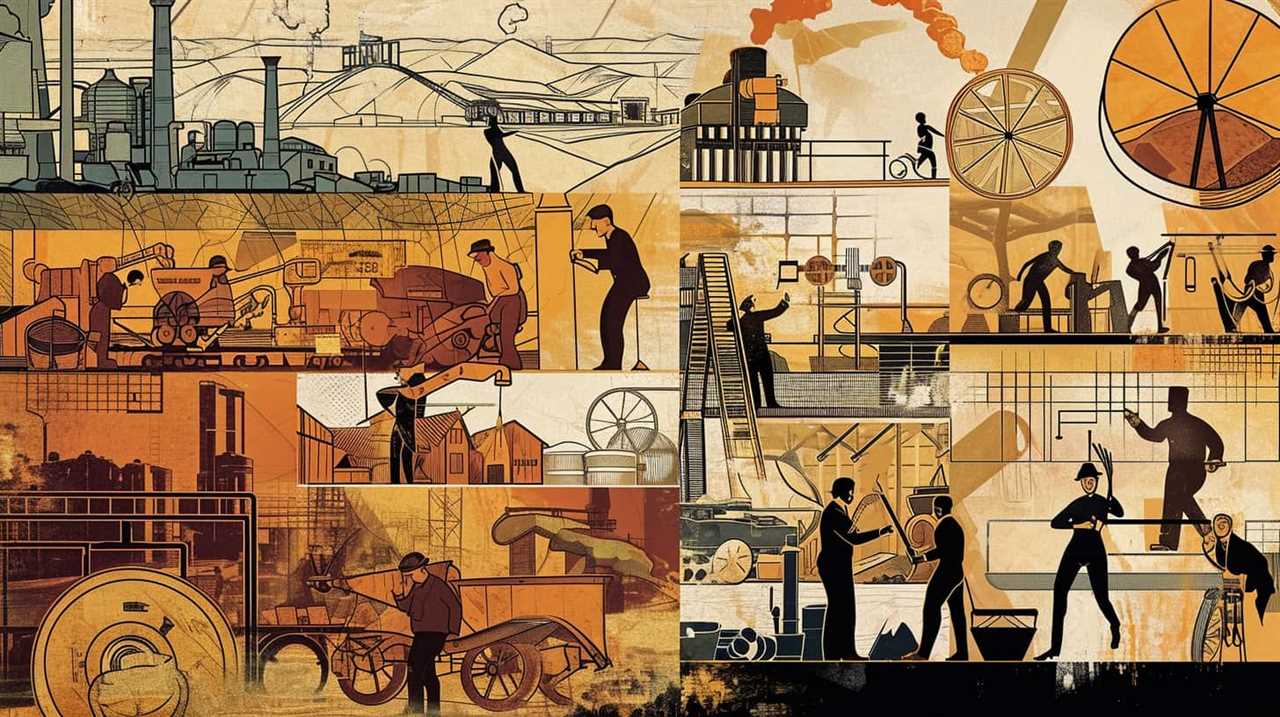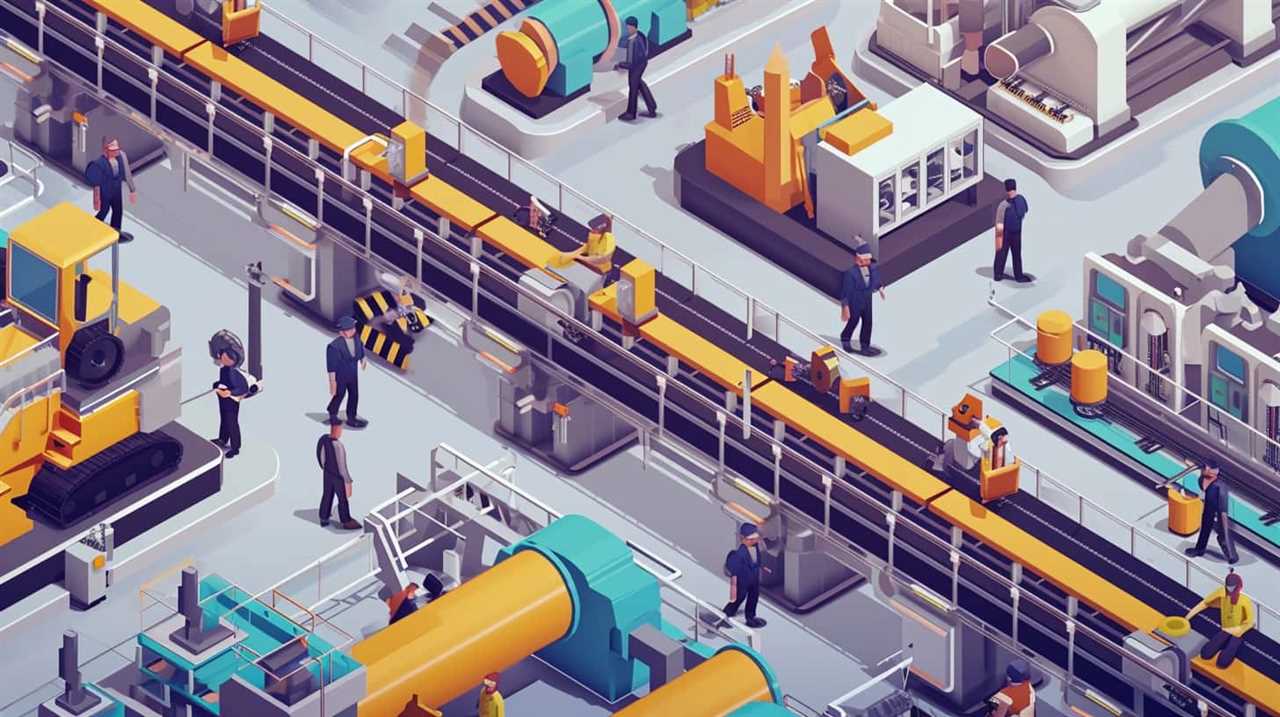Are you interested in uncovering the reality behind the concept of the invisible hand and how it contributes to economic stability? We are intrigued as well! Join us as we investigate the enigmatic mechanisms of the invisible hand and its influence on establishing market balance.
This innovative journey will take us through the fascinating concept first introduced by Adam Smith, where self-interest interacts with supply and demand to create a harmonious economic system. We will also examine both historical examples and modern-day relevance to understand the invisible hand’s influence on government intervention and its limitations.
Get ready to unlock the secrets of the invisible hand and discover how it contributes to the dynamic balance of our economies.
Key Takeaways
- The Invisible Hand Theory, proposed by Adam Smith, suggests that individuals acting in their own self-interest can unintentionally promote economic balance and prosperity for society as a whole.
- The Invisible Hand influences supply and demand by guiding individuals to produce goods and services that are in demand, leading to market equilibrium.
- While the Invisible Hand theory promotes market self-regulation and benefits such as innovation and efficiency, it has limitations such as ignoring externalities, market failures, and income inequality.
- Historical examples of the Invisible Hand in action include the Industrial Revolution, post-World War II economic growth in Japan and Germany, and the promotion of innovation and prosperity.
Definition of the Invisible Hand
The definition of the invisible hand is an economic theory that suggests the market, through the actions of self-interested individuals, can efficiently allocate resources and achieve economic balance. Market forces, such as supply and demand, competition, and price signals, drive this process. These forces act as the invisible hand that guides the market towards economic efficiency.

Market forces are the interactions between buyers and sellers that determine the prices and quantities of goods and services. They’re influenced by various factors, including consumer preferences, technological advancements, and government policies. The invisible hand represents the collective actions of individuals pursuing their own self-interests, which ultimately results in the optimal allocation of resources and the achievement of economic balance.
The concept of the invisible hand was first introduced by Adam Smith, a renowned economist and philosopher, in his book ‘The Wealth of Nations.’ Smith argued that when individuals are free to pursue their own economic interests, they inadvertently promote the greater good of society. This theory revolutionized economic thought and laid the foundation for modern market economies.
Adam Smith’s Theory of the Invisible Hand
Now let’s delve into Adam Smith’s theory of the invisible hand and its role in economic balance. According to Smith, the invisible hand is a concept that suggests that individuals, driven by their self-interest, unintentionally contribute to the overall economic well-being of society. This theory is based on the idea that when individuals pursue their own interests, they’re led by an invisible hand to promote the greater good of society as a whole.
Adam Smith’s theory of the invisible hand has several key implications for economic balance:

- Market Efficiency: Smith believed that individuals acting in their own self-interest would lead to an efficient allocation of resources. This means that goods and services are produced and distributed in a way that maximizes overall societal welfare.
- Competition: The invisible hand theory suggests that competition in the marketplace is essential for economic balance. When multiple firms compete for customers, it leads to innovation, lower prices, and improved quality of goods and services.
- Self-Regulation: Smith argued that markets have a natural tendency to self-regulate. This means that market forces, such as supply and demand, would automatically adjust to achieve equilibrium and prevent imbalances.
The Role of Self-Interest in Economic Balance
Our self-interest plays a pivotal role in maintaining economic balance. As individuals, we’re naturally driven by our desires to maximize our own well-being and satisfaction. This self-interest fuels our actions and decisions in the economic sphere, ultimately contributing to the overall efficiency and equilibrium of the market.
One key aspect of self-interest in the context of economic balance is the role of incentives. Incentives, whether in the form of financial rewards, social recognition, or personal fulfillment, encourage individuals to pursue activities that benefit themselves and others. For instance, the promise of higher profits can motivate entrepreneurs to innovate and create new products or services that meet the needs and desires of consumers. This drive for self-interest, combined with the pursuit of profit, leads to market competition and the constant search for efficient and effective ways to meet consumer demands.
Additionally, self-interest acts as a mechanism for market efficiency. When individuals act in their own self-interest, they naturally seek the most advantageous opportunities and outcomes. This pursuit of self-benefit encourages the allocation of resources in the most efficient manner, as individuals evaluate costs and benefits to make rational decisions. The invisible hand of self-interest guides the market towards equilibrium, ensuring that goods and services are produced and consumed at optimal levels, and resources are allocated to their most valued uses.
How the Invisible Hand Influences Supply and Demand
One key factor in maintaining economic balance is the influence of the invisible hand on the interaction between supply and demand. The invisible hand, as described by Adam Smith, refers to the self-regulating nature of the market that leads to an equilibrium between buyers and sellers. It’s through the invisible hand that market dynamics are shaped and consumer behavior is influenced.

The invisible hand’s influence on market dynamics can be seen in several ways:
- Price mechanism: The invisible hand guides the market towards the determination of prices based on the forces of supply and demand. It ensures that prices adjust in response to changes in market conditions, leading to an efficient allocation of resources.
- Market competition: The invisible hand promotes competition among producers, leading to innovation, efficiency, and better products. This competition ensures that resources are allocated to their most productive uses, benefiting both producers and consumers.
- Market equilibrium: The invisible hand works to achieve a state of equilibrium where the quantity supplied equals the quantity demanded. It ensures that resources are allocated efficiently, preventing shortages or surpluses in the market.
The invisible hand’s effect on consumer behavior is also significant. It influences consumers’ choices and preferences by offering a wide range of products and prices. Consumers are empowered to make decisions based on their own self-interest, leading to a more diverse and responsive market.
Market Equilibrium and the Invisible Hand
Market equilibrium is a state in which the quantity demanded by consumers matches the quantity supplied by producers, resulting in a balance between supply and demand.
The concept of the invisible hand refers to the idea that market forces, such as supply and demand, act as an invisible force that guides the economy towards this equilibrium.

This self-regulation mechanism allows for efficient allocation of resources, as prices adjust to reflect the changing conditions of the market.
Invisible Hand Explained
We can better understand the concept of the invisible hand through exploring how market equilibrium is achieved. Market equilibrium occurs when the supply of a good or service matches the demand for it, resulting in an efficient allocation of resources. The invisible hand, as described by Adam Smith, refers to the self-regulating nature of markets that leads to this equilibrium. It’s significant because it suggests that individuals pursuing their self-interest can unintentionally benefit society as a whole.
The implications of the invisible hand are profound. It implies that government intervention in markets should be minimal, allowing market forces to guide resource allocation. It also suggests that competition is essential for market efficiency, as it drives innovation and improves consumer welfare. Furthermore, the invisible hand highlights the importance of information and price signals in coordinating economic activity.
Market Self-Regulation Benefits
The benefits of market self-regulation, specifically market equilibrium and the invisible hand, are crucial for understanding the efficient allocation of resources. Market equilibrium occurs when the quantity demanded by consumers matches the quantity supplied by producers, resulting in a balance between supply and demand. This balance leads to efficient resource allocation, as prices adjust to reflect the scarcity or abundance of goods and services. The invisible hand, a concept introduced by Adam Smith, refers to the self-regulating nature of markets, where individual pursuit of self-interest can lead to the overall well-being of society. It ensures that resources are allocated efficiently, goods and services are produced according to consumer preferences, and innovation and competition are encouraged. The table below highlights the advantages of market self-regulation:

| Benefits of Market Self-Regulation |
|---|
| Efficient resource allocation |
| Price discovery |
| Incentives for innovation |
| Competition and consumer choice |
| Economic growth and prosperity |
Role of Supply-Demand
Efficient allocation of resources hinges on the delicate balance between supply and demand. The role of consumers in this balance is crucial, as their preferences and purchasing decisions directly influence the demand for goods and services.
At the same time, the impact of technology can’t be ignored. Technological advancements have revolutionized the way consumers interact with the market, allowing for greater convenience, customization, and access to information. This has led to a shift in demand patterns, with consumers increasingly seeking innovative and technologically advanced products.
As a result, businesses must adapt and respond to these changing demands to maintain market equilibrium. The invisible hand of the market plays a vital role in ensuring that supply and demand align efficiently, fostering competition and driving innovation.
Invisible Hand’s Impact on Prices and Competition
One might argue that the invisible hand’s impact on prices and competition is crucial in maintaining economic balance. The concept of the invisible hand, introduced by Adam Smith in his book "The Wealth of Nations," suggests that individuals pursuing their own self-interest in a free market economy ultimately benefit society as a whole. This idea extends to the realm of prices and competition, where the invisible hand plays a significant role in shaping market dynamics and promoting efficiency.

To understand the invisible hand’s impact on prices and competition, let’s examine the table below:
| Impact of Invisible Hand on Prices and Competition | Examples |
|---|---|
| Promotes price competition, leading to lower prices and better consumer welfare | E-commerce platforms like Amazon driving down prices through increased competition |
| Encourages innovation and product differentiation, fostering healthy market competition | Technological advancements in smartphones leading to a wide range of options and features |
| Facilitates efficient allocation of resources, optimizing production and consumption | Supply and demand forces determining the ideal quantity of goods produced and consumed in a market |
| Prevents monopolistic behavior, ensuring fair competition and protecting consumers | Antitrust laws preventing companies from engaging in anti-competitive practices |
| Enhances market transparency, enabling informed decision-making | Price comparison websites providing consumers with information to make informed purchasing choices |
As seen in the table, the invisible hand’s impact on prices and competition is multifaceted. It promotes competition, innovation, efficiency, and consumer protection. By allowing market forces to determine prices and encouraging healthy competition, the invisible hand helps to create an environment where businesses strive to meet consumer demands while also ensuring fair and transparent market practices.
Criticisms and Limitations of the Invisible Hand Concept
Now, let’s delve into the criticisms and limitations surrounding the concept of the invisible hand and its role in economic balance. While the invisible hand theory has been widely accepted and praised for promoting economic efficiency and individual freedom, it isn’t without its critics. Here are some of the main criticisms and limitations of the invisible hand concept:
- Limited information: One major criticism is that the invisible hand relies on the assumption of perfect information. In reality, individuals and firms may not have access to complete and accurate information, leading to market inefficiencies and failures.
- Externalities: The invisible hand theory fails to account for external costs or benefits that affect third parties. For example, pollution caused by industrial activities may have negative effects on the environment and public health, but these costs aren’t reflected in market prices.
- Market power: The invisible hand assumes perfect competition, where no single buyer or seller has the power to influence prices. However, in many markets, monopolies or oligopolies exist, leading to higher prices and reduced competition.
While the invisible hand concept has its limitations, it still remains a valuable framework for understanding how market forces can lead to economic balance. By recognizing these criticisms, we can strive to improve our understanding of market dynamics and work towards creating more inclusive and efficient economic systems.

Historical Examples of the Invisible Hand in Action
As we delve into historical examples of the invisible hand in action, we can see how market forces have shaped economic outcomes throughout time.
One notable historical example is the Industrial Revolution, which took place in the late 18th and early 19th centuries. During this period, advancements in technology and manufacturing led to a significant increase in productivity and economic growth. The invisible hand of the market played a crucial role in this transformation, as entrepreneurs and businesses responded to consumer demand and competed to provide goods and services more efficiently.
Another example can be found in the post-World War II era, where countries like Japan and Germany experienced rapid economic growth and recovery. These nations embraced market-oriented policies and relied on the invisible hand to allocate resources and foster competition. As a result, they were able to rebuild their economies and become global economic powerhouses.
These historical examples highlight the real-life applications of the invisible hand concept. Market forces, driven by supply and demand dynamics, have consistently shown their ability to promote innovation, efficiency, and economic prosperity.

However, it’s important to note that the invisible hand isn’t a panacea and can lead to negative externalities, such as income inequality or environmental degradation. This necessitates a discussion on the role of government intervention, which we’ll explore in the next section.
The Invisible Hand and Government Intervention
When considering the role of the Invisible Hand in relation to government intervention, it’s important to weigh the advantages and disadvantages of each approach.
On one hand, proponents argue that a free market system allows for greater efficiency and innovation, as market forces naturally regulate themselves.
On the other hand, critics argue that government intervention can help mitigate market failures, provide public goods, and promote social welfare.

Finding a balance between these two forces is crucial for maintaining economic stability and maximizing societal well-being.
Government Vs. Free Market
Our analysis shows that a minimal level of government intervention is essential to maintain a healthy balance between the free market and the invisible hand. While the free market promotes competition, innovation, and efficient allocation of resources, government intervention is necessary to ensure market efficiency and prevent market failures.
Government intervention can correct externalities, such as pollution or unfair competition, that the free market may not adequately address. It can provide public goods, like infrastructure or education, that are necessary for economic growth and development. Government regulation can also protect consumers from exploitation and ensure fair market practices.
However, excessive government intervention can stifle innovation and hinder economic growth. Striking the right balance between government intervention and free market forces is crucial for fostering a dynamic and innovative economy while also ensuring social welfare and market efficiency.

Balancing Economic Forces
The article explores the role of the invisible hand and government intervention in balancing economic forces.
The invisible hand, as proposed by Adam Smith, suggests that market self-regulation leads to economic equilibrium.
Government intervention can play a significant role in maintaining balance.
Government intervention refers to the actions taken by authorities to influence economic activities.

It can be in the form of regulations, taxes, subsidies, or even direct control over certain industries.
These interventions are often aimed at correcting market failures, promoting fairness, and ensuring stability.
By addressing issues such as externalities, monopolies, and income inequality, government intervention can help create a more efficient and equitable economic system.
However, it’s important to weigh the pros and cons of intervention to determine the optimal level of government involvement.

Intervention: Pros and Cons
One key consideration in evaluating government intervention is weighing the pros and cons of its impact on the invisible hand’s role in economic balance. Government intervention can have both positive and negative effects on the functioning of the market.
Pros of government intervention include:
- Correcting market failures: Government intervention can address market failures such as externalities or monopolies that result in the inefficient allocation of resources.
- Promoting fairness: Intervention can help ensure a more equitable distribution of wealth and opportunity, reducing social inequalities.
- Stimulating innovation: Government intervention can encourage innovation by providing funding and incentives for research and development.
However, there are also cons to government intervention:
- Market distortions: Intervention can create market distortions, such as price controls or subsidies, which may lead to inefficient resource allocation.
- Decreased efficiency: Excessive intervention can stifle competition and entrepreneurship, hindering economic growth.
- Regulatory burden: Government intervention often involves complex regulations and bureaucracy, which can increase costs for businesses and hinder innovation.
Finding the right balance between government intervention and the invisible hand’s operation is crucial to ensuring a well-functioning and innovative economy.

The Relevance of the Invisible Hand in Modern Economies
How does the invisible hand still play a significant role in shaping modern economies?
In today’s highly interconnected and dynamic global economy, the concept of the invisible hand continues to hold relevance. While government intervention is necessary in certain areas to address market failures and ensure social welfare, the invisible hand, representing the forces of supply and demand, remains a powerful driver of economic outcomes.
One key aspect of the invisible hand’s relevance lies in its impact on income distribution. Adam Smith, the economist who first introduced the concept, argued that individuals pursuing their own self-interest in a competitive market would ultimately lead to the betterment of society as a whole. This notion still holds true today, as market mechanisms play a crucial role in determining the distribution of wealth and income. The invisible hand ensures that resources are allocated efficiently, allowing for the creation of wealth and opportunities for individuals to improve their economic well-being.
Furthermore, the invisible hand promotes innovation and entrepreneurship in modern economies. By allowing market forces to guide economic decisions, it incentivizes individuals and businesses to seek out new opportunities, develop innovative products, and improve productivity. This entrepreneurial spirit drives economic growth, fosters technological advancements, and enhances overall societal welfare.

Frequently Asked Questions
How Does the Concept of the Invisible Hand Impact the Distribution of Wealth and Income in Society?
The concept of the invisible hand impacts the distribution of wealth and income in society by promoting social mobility and mitigating criticism of wealth inequality through its natural market forces and incentives.
Can the Invisible Hand Theory Be Applied to Non-Market Economies?
The application of the invisible hand theory to non-market economies has limitations. While it may still play a role in guiding resource allocation, the absence of price signals and competition makes its effectiveness uncertain.
Is the Invisible Hand Theory Still Relevant in Today’s Globalized and Interconnected World?
In today’s globalized world, the relevance of the invisible hand theory is still apparent. Its impact on emerging economies and role in technological advancements make it a powerful force driving innovation and economic balance.
What Are Some Alternative Theories or Concepts That Challenge or Complement the Invisible Hand Theory?
Alternative theories and complementary concepts challenge the invisible hand theory. These include theories like market socialism, behavioral economics, and ecological economics, which offer different perspectives on how economic balance can be achieved in today’s world.

Are There Any Ethical or Moral Considerations Associated With the Invisible Hand Theory and Its Implications on Economic Balance?
Ethical considerations and moral implications are important when examining the invisible hand theory’s impact on economic balance. We must analyze the effects on societal well-being and address any potential inequalities that may arise.
How Does Ricardo’s Comparative Advantage Theory Impact the Invisible Hand’s Role in Economic Balance?
Ricardo’s comparative advantage theory plays a critical role in exploring Ricardo’s comparative advantage and its impact on the invisible hand’s role in economic balance. By recognizing each country’s unique strengths, trade can be optimized to benefit all parties, leading to a more balanced and efficient global economy.
Conclusion
In summary, the invisible hand serves as a guiding force in maintaining economic balance by allowing self-interest to drive supply and demand.
Despite its limitations and criticisms, historical examples have shown the invisible hand’s effectiveness in achieving market equilibrium.
It’s important for governments to recognize the relevance of this concept in modern economies and carefully consider the impact of their interventions.

Ultimately, the invisible hand remains a crucial factor in ensuring the stability and efficiency of economic systems.
Lauren’s talent in writing is matched by her passion for storytelling. Her love for books and deep understanding of culture and entertainment add a distinct flavor to her work. As our media and press contact, Lauren skillfully bridges the gap between afterQuotes and the broader media landscape, bringing our message to a wider audience.










